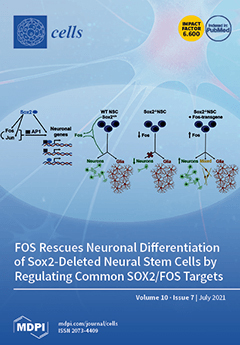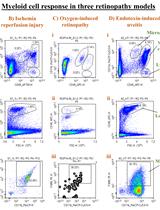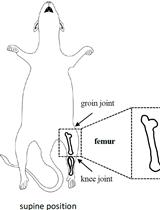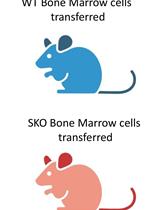- EN - English
- CN - 中文
Flow Cytometric Characterization of Macrophages Infected in vitro with Salmonella enterica Serovar Typhimurium Expressing Red Fluorescent Protein
表达红色荧光蛋白的肠沙门氏菌血清鼠伤寒菌体外感染巨噬细胞的流式细胞术研究
发布: 2022年06月05日第12卷第11期 DOI: 10.21769/BioProtoc.4440 浏览次数: 3035
评审: Tomas AparicioSonal Patel PatelSaskia F. ErttmannAnonymous reviewer(s)
Abstract
Macrophages are important for host defense against intracellular pathogens like Salmonella and can be differentiated into two major subtypes. M1 macrophages, which are pro-inflammatory and induce antimicrobial immune effector mechanisms, including the expression of inducible nitric oxide synthase (iNOS), and M2 macrophages, which exert anti-inflammatory functions and express arginase 1 (ARG1). Through the process of phagocytosis, macrophages contain, engulf, and eliminate bacteria. Therefore, they are one of the first lines of defense against Salmonella. Infection with Salmonella leads to gastrointestinal disorders and systemic infection, termed typhoid fever. For further characterization of infection pathways, we established an in vitro model where macrophages are infected with the mouse Salmonella typhi correlate Salmonella enterica serovar Typhimurium (S.tm), which additionally expresses red fluorescent protein (RFP). This allows us to clearly characterize macrophages that phagocytosed the bacteria, using multi-color flow cytometry.
In this protocol, we focus on the in vitro characterization of pro- and anti-inflammatory macrophages displaying red fluorescent protein-expressing Salmonella enterica serovar Typhimurium, by multi-color flow cytometry.
Background
The intracellular Gram-negative bacterium Salmonella typhi can cause severe and often life-threatening disease in humans. Globally, approximately 200,000 deaths are caused by the bacterium every year. The intracellular pathogen is ingested through contaminated food, and transmitted from person to person. The mouse correlate of human Salmonella typhi is Salmonella enterica serovar Typhimurium (S.tm). The intracellular bacteria are phagocytosed by macrophages and are able to evade antimicrobial defense by inhibiting fusion of lysosome and phagosome. Therefore, S.tm is able to survive and replicate inside the host (Buchmeier and Heffron, 1991; Navarre et al., 2010; Lahiri et al., 2010; Mastroeni and Grant, 2011; Bhutta et al., 2018).
In general, the immune system is divided into cells of the innate immune system (monocytes, macrophages, dendritic cells, and natural killer cells), and the acquired immune system (B lymphocytes, and T lymphocytes). Macrophages are phagocytic cells of the innate immune system, and one of the body's first defense mechanisms, when a pathogen crosses the host’s skin barrier. They can be classified into two types: (I) M1 pro-inflammatory macrophages, which are responsible for killing bacterial and viral pathogens, and express inducible nitric oxide synthase (iNOS), and (II) M2 macrophages, which support the wound healing process, and have an anti-inflammatory effect. Importantly, M2 macrophages express the enzyme arginase 1 (ARG1) (Mosser and Edwards, 2008; Mills, 2012; Weiss and Schaible, 2015; Gordon and Martinez-Pomares, 2017; Murray, 2017; Hannemann et al., 2019).
The cytosolic enzyme ARG1 is primarily expressed in liver tissue. During infection, ARG1 upregulation promotes pathogen survival in macrophages, by hydroxylating l-arginine to urea and ornithine, which therefore lowers l-arginine levels for the synthesis of nitric oxide (NO) by iNOS. A fully functional iNOS needs an adequate l-arginine supply to produce NO that kills pathogens. Interferon gamma (IFNγ) and tumor necrosis factor alpha (TNFα) are potent inducers of iNOS (Nairz et al., 2013; Bogdan, 2015; Brigo et al., 2021). ARG1 is induced by interleukin 4 (IL-4), which is produced by type 2 T helper cells. TNFα and IFNγ inhibit the transcription of ARG1, by interfering with IL-4–induced chromatin remodeling (Ostuni and Natoli, 2011; Schleicher et al., 2016; Piccolo et al., 2017). Additionally, several studies show that increased ARG1 activity is associated with an increased concentration of various pathogens, such as Streptococcus pneumoniae, Mycobacterium bovis, Mycobacterium tuberculosis, or Toxoplasma gondii (Iniesta et al., 2005; El Kasmi et al., 2008; De Muylder et al., 2013; Schleicher et al., 2016; Paduch et al., 2019). However, it has been reported that deletion or pharmacological inhibition of ARG1 does not lead to a better control of Salmonella infection in macrophages, or in mice, in a septicemia model (Brigo et al., 2021).
Current treatment against invasive salmonellosis with antibiotics has become more difficult, due to resistance against conventional antibiotics. Therefore, the identification of new mechanisms to better understand the host-pathogen interplay in Salmonella infection, and the detailed characterization of the cells involved in the defense against this infection are urgently needed. Herein, we describe a method that identifies pro- and anti-inflammatory bone marrow-derived macrophage subtypes, during an infection with Salmonella enterica serovar Typhimurium. Furthermore, Salmonella expressing red fluorescent protein allows the visualization of phagocytosed Salmonella in these subtypes. This method supports further research on the involvement of pro- and anti-inflammatory macrophages in the defense against Salmonella.
Materials and Reagents
250 mL Erlenmeyer flask (Stoelzle Medical, catalog number: 21226368000)
0.5 mL Eppendorf tubes (Eppendorf, catalog number: 0030121.023)
Disposable cuvette (BRAND, catalog number: 759015)
1.5 mL Eppendorf tubes (Eppendorf, catalog number: 0030120.086)
Cell scraper (Sarstedt, catalog number: 83.3951)
15 mL Polypropylene conical tube (Falcon, catalog number: 352096)
Cell strainer 40 µm (Falcon, catalog number: 352360)
96-well BRAND plate (Life Science Products, catalog number: 781602)
5 mL disposable syringe (BD, catalog number: 309050)
Luna cell counting slides (Biocat, catalog number: L201B1C3GB)
6-cm dish (TTP, catalog number: 93060)
Salmonella enterica serovar Typhimurium SL1344 expressing red fluorescent protein (RFP) (Birmingham et al., 2006; Wu et al., 2017)
Lysogeny broth (LB Broth) Lennox (Roth, catalog number: X964.2)
Glycerol (Sigma, catalog number: G5516-100ML)
Phosphate buffer saline (PBS; Lonza, catalog number: 17-515 F)
Agar-Agar Kobe I (Roth, catalog number: 5210.3)
CASY Cup (OMNI Life Science, catalog number: 5651794)
CASY Ton Buffer (OMNI Life Science, catalog number: 5651808)
Aqua bidest (Fresenius Kabi, catalog number: 16.231)
Gentamicin (Gibco, catalog number: 15750-037)
L-glutamine (Lonza, catalog number: BE17-605E)
Dulbecco′s Modified Eagle′s Medium (DMEM, Pan BiotechTM, catalog number: P04-01500)
Fetal bovine serum (FBS, Pan BiotechTM, catalog number: P30-3031)
BV650 anti-mouse/human CD11b (BioLegend, catalog number: 101239)
APC-R700 rat anti-mouse CD45 (BDHorizonTM, catalog number: 565478)
BV421 rat anti-mouse F4/80 (BD Biosciences; catalog number: 565411)
PerCP-eFluorTM 710 anti-mouse Ly6G (Invitrogen; catalog number: 46-9668-82)
FITC anti-mouse CD3 (BioLegend, catalog number: 100204)
FITC anti-mouse CD19 (ImmunoTools, catalog number: 22220193S)
FITC anti-mouse CD49b (BioLegend, catalog number: 103503)
PE-Cyanine7 anti-mouse iNOS (Invitrogen; catalog number: 25-5920-80)
APC anti-mouse ARG1 (Invitrogen, catalog number: 17-3697-82)
BD Cytofix/CytopermTM (BD Biosciences, catalog number: 51-2091K7)
BD PermWashTM (BD Biosciences, catalog number: 51-2090K7)
50 mL Polypropylene conical tube (Falcon, catalog number: 352070)
Ketamine (Livisto, catalog number: 6680219)
Xylazine (Animedica, catalog number: 7630517)
Omnican F syringes (Braun, catalog number: 91615025)
Disposable hypodermic needle 100 Sterican R (Braun, catalog number: 4657519)
Pen-Strep (Lonza, catalog number: DE17-602E)
Erythrocyte lysis buffer (R&D, catalog number: WL2000)
Acridine Orange/propidium iodide stain (Biocat, catalog number: F23001)
LB medium (see Recipes)
LB-medium with 30% Glycerol (see Recipes)
Equipment
Laminar Flow Cabinet; EuroClone Safe Mate Eco 1.2 (Politakis Laborgeräte, catalog number: EN 12 469)
Shaking incubator (VWR, catalog number: GFL 3031)
Heraeus® HERAcell® CO2 Incubator (Thermo Fisher Scientific, catalog number: 3615-45)
Photometer (Eppendorf, BioPhotometer D30, catalog number: 6133000001)
Centrifuge (Hettich Micro 200R and Rotanta 460R, catalog number: Z652113, Z623520)
CASY TT counting system (OMNI Life Science, catalog number: TT-20A-2571)
CytoFLEX S V4-B4-R2-I2 Flow Cytometer (13 detectors, 4 lasers, Beckman Coulter, catalog number: C01161)
LUNA Automated Cell Counter (Biocat, L10001-LG)
Software
FlowJo v10.7.0 (BD Biosciences, https://www.flowjo.com/solutions/flowjo)
Note: Any software package for analyzing flow cytometry data can be used with this protocol.
Procedure
文章信息
版权信息
© 2022 The Authors; exclusive licensee Bio-protocol LLC.
如何引用
Brigo, N., Pfeifhofer-Obermair, C., Demetz, E., Tymoszuk, P. and Weiss, G. (2022). Flow Cytometric Characterization of Macrophages Infected in vitro with Salmonella enterica Serovar Typhimurium Expressing Red Fluorescent Protein. Bio-protocol 12(11): e4440. DOI: 10.21769/BioProtoc.4440.
分类
免疫学 > 免疫细胞染色 > 流式细胞术
细胞生物学 > 细胞染色
您对这篇实验方法有问题吗?
在此处发布您的问题,我们将邀请本文作者来回答。同时,我们会将您的问题发布到Bio-protocol Exchange,以便寻求社区成员的帮助。
Share
Bluesky
X
Copy link













